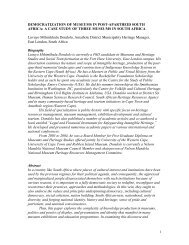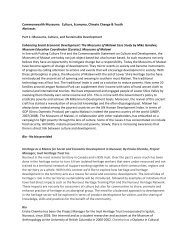You also want an ePaper? Increase the reach of your titles
YUMPU automatically turns print PDFs into web optimized ePapers that Google loves.
The sign artist did a test on the signs, and on applying and removing the vinyl stencils,some of the paint came off. The supplier had not primed the metal surfaces be<strong>for</strong>e painting,a process I only learnt about after the damage had been done. I called the supplier, whoreluctantly agreed to redo the job. This took about two weeks, after which the sign artistswere back at it again. We still encountered problems of peeling paint, so the sign artists hadto prime and paint the signs yet again. On the whole, the job took close to three weeks.The next stage was to pack the signs <strong>for</strong> transport, and this was done using foam andcraft paper - a process that took two full days. The signs were ready <strong>for</strong> transportation toSuba and we hired a lorry to deliver them to Mbita, after which they would be loaded intoa large wooden boat to Mfangano Island. We loaded the lorry until about midnight in thepouring rain and mud, and then wished the crew a good journey the following morning.Their journey began by getting stuck in the mud (while I was not a witness, I was told thatsomebody said a prayer and the lorry moved!), and there were numerous problems withthe police along the way. To crown it all, the driver took a longer route and arrived at Mbita13 hours later, at around 10pm. Jack had organised <strong>for</strong> a group of community volunteers tohelp offload and pitch the signs the following day.The journey across the lake with the signs was an adventure. Crossing the rough lake inthe night with a huge consignment of signs and over 20 youths in the boat was the stuffthat action movies are made of. The volunteers began setting up the signs in earnest thefollowing day, with the signs near the museum being erected first, as well as those of theKouko site on the mainland. The next day the signs of Kwitone and Mawanga were set up.After a host of logistical problems, the Kwitone and Mawanga signs were eventually pitchedby 7pm, having started at 7am. Even this was not without its problems – carrying the signsup the hill to the site, as well as cement, sand and water -- It was a demanding job!35On returning from Kwitone, we noticed that the signs on the route back were mostly erectedthe wrong way around. The signs were designed with an ascent and descent route inmind. The descent route had several problems. This was later rectified in an exercisethat took another full day. Finally, what looked like a ‘mission impossible’ was a missionaccomplished!








